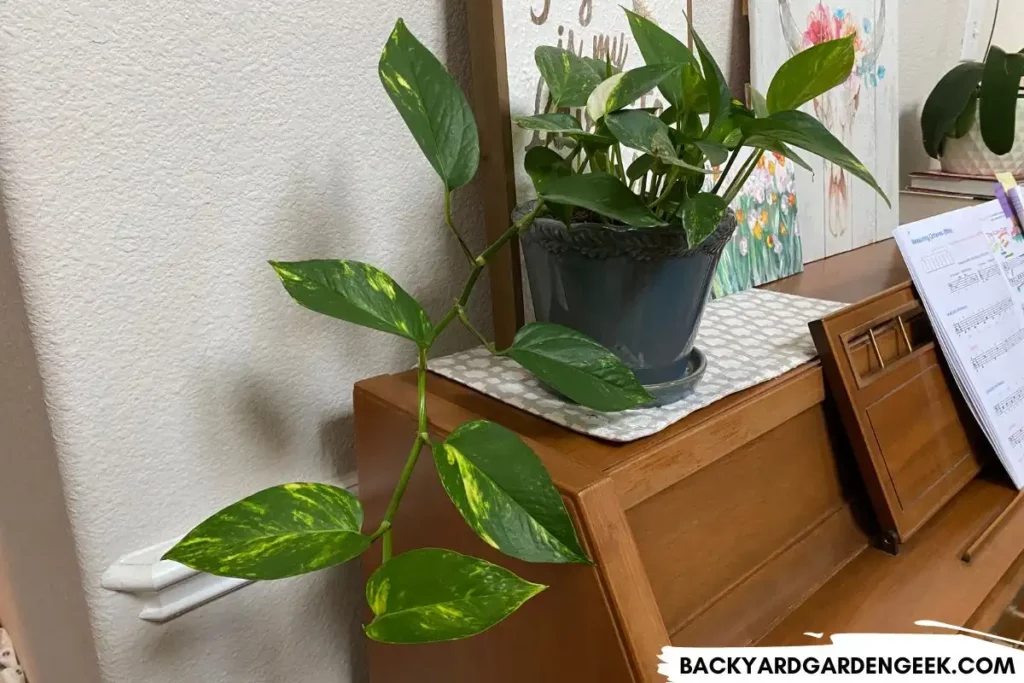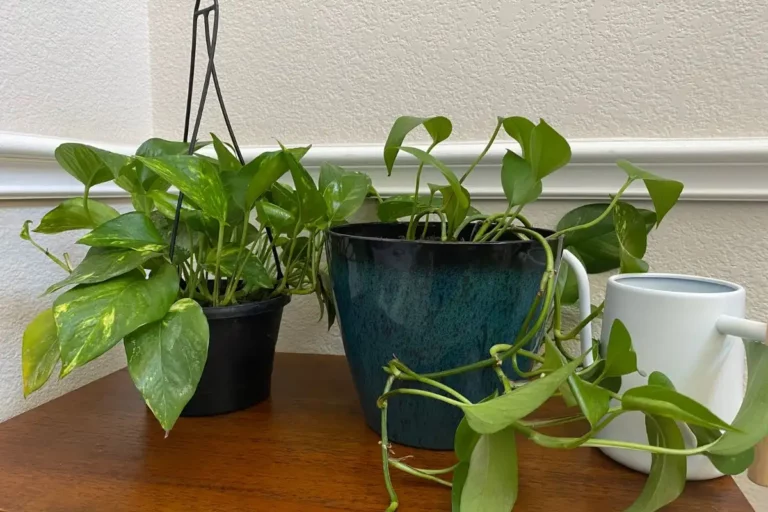Can I Put My Pothos in the Sun? Outdoor Care and Caution
If you love your houseplants but are ready to spend more time outside as the weather warms up, you may wonder if you can bring some houseplants outside to spruce up your outdoor living space.
For instance, I love pothos plants, but I usually keep them inside. Can I put my pothos outside, even if it means it’ll get direct sunlight?
Pothos plants can tolerate outdoor environments and limited exposure to direct sunlight, but they typically prefer partial sunlight. If left in direct sunlight for extended periods of time, pothos will experience leaf burn, so care must be taken when placing pothos plants outdoors.
The last thing I want to do is burn my pothos plants—especially since they’re relatively slow-growing compared to the plants in my garden—so I’d like to share a few tips with you when it comes to growing and caring for pothos, including:
- understanding more about the best environmental conditions for your pothos plants.
- knowing when and how to transition your pothos plants outside during the warmer months of the year.
- learning about the potential risks of transitioning your pothos plants outside, especially risks related to heat and direct sunlight exposure.
With the right care and attention, your pothos plants will do just fine outside, so let’s look at the details so you can begin sprucing up your patio, porch, or any other outdoor living space!
The Best Environment for Your Pothos Plants: 3 Simple Tips
Pothos (Epipremnum aureum), commonly known as devil’s ivy, is a popular houseplant known for being both beautiful and easy to care for. Native to tropical regions, pothos plants thrive in environments that mimic their natural habitat.
In their natural environment, pothos plants flourish on the rainforest floor where they enjoy the shade of large trees and dense foliage, lots of humidity, and plenty of room to climb.

If you want the happiest possible pothos plant, you’ll want to give it what it needs to flourish.
Here’s what you’ll need for your pothos plants to do as well as they possibly can:
1. Bright, Indirect Light
Pothos plants prefer indirect or dappled sunlight.
While they can tolerate some direct sunlight, your pothos will suffer if it’s exposed to intense afternoon rays, and prolonged exposure to direct sunlight will likely lead to leaf burn.
To avoid burning your pothos plant, you can always leave it indoors, but your outdoor living areas won’t benefit from the touch of green it’ll bring to them.
So here’s what I suggest instead: Locate an area outside that’ll get no more than 1-2 hours of direct sunlight per day. If you’ve got places on your patio or porch that get indirect or dappled sunlight throughout the day, that’s even better!
When you transition your pothos outside, please make sure to check the soil’s moisture at least once every 2 days or so. The smaller the pot and the more direct the sunlight, the more often you’ll need to water your pothos plant.
2. High Humidity
Pothos are resilient and can survive in low-humidity environments just fine, but as I noted above, they love adequate to high-humidity environments best.
If you’re going to put your pothos outside, you’ve got to make sure it gets the water it needs, especially if you live in a hotter or dryer region.

To keep your plant happy, consider misting its leaves on a regular basis, assuming it’s in partial sunlight, and keep the soil moist but not soaked.
Between the dappled sunlight and the moisture, your pothos will do fine outside in areas that get some sun.
3. Warm Temperatures
When it comes to temperature, pothos plants prefer a warm and consistent climate.
Ideally, temperatures between 70-90°F (21-32°C) are suitable for their growth.
One challenge with growing pothos plants outside is keeping things ideal in terms of temperature.
I live in North Texas, and if you put any pothos plants outside here during the summer months, you’ll likely kill them if they’re exposed to anything more than dappled sunlight. The sun and heat are just too strong.
Although pothos can handle outdoor environments, you should only plant them directly in the ground if you live in a tropical region and have the right kind of growing conditions on your property.
(And lucky you if you live in one of these regions. You might even get to see your pothos plants flower!)
In the United States, pothos will do best outdoors in hardiness zones 8-12. These regions provide the warmth and humidity that closely resemble the pothos’ native tropical environment (especially Florida and Hawaii).
In other areas of the United States, pothos will do just fine outside during the summer months. But in many places, it gets colder earlier and stays colder longer than it does in zones 8-12, so you’ll generally have less time for your photos to live outside than those who live in warmer regions.
Read on to see how you can provide the right balance of light, humidity, and temperature to enjoy your pothos plants not just within the comforts of your home but in your outdoor spaces too!
Moving Indoor Plants Outdoors for Summer

Unless you’re willing to take proper care of them, you shouldn’t move your pothos outside during the summer.
But if you’ve got the right conditions on your porch or patio—and if the weather isn’t too extreme outside—your pothos might grow faster and larger when exposed to partial, dappled sunlight, warm weather, and plenty of humidity and moisture.
(This is why pothos plants thrive in Florida but need lots of extra love here in North Texas!)
Before hauling your pothos plants outside, consider a few things:
Ensure that temperatures are at least 70°F (21°C) and bring your plants inside if the temperature is going to drop into the 50s (around 10°C). Sudden temperature fluctuations will hurt your plant and require you to bring it back inside.
This is what makes Texas so tricky: The temperatures here fluctuate all the time!
Also, think about how humid your climate is. Exercise caution if you live in a dry area, as the lack of sufficient humidity can negatively impact the plants’ health.
Once the weather feels right, choose a spot for your pothos with bright indirect light or dappled sunlight.
After spending the winter indoors, direct sunlight can shock the plant, so please don’t just put it outside without giving some thought to the location.
Once you’ve found the perfect spot for your pothos, keep in mind that outdoor plants generally require more frequent watering. The increased exposure to sunlight and airflow causes the soil to dry out more quickly, necessitating regular monitoring and adequate hydration.
Typically, I’d recommend watering an indoor pothos every week or so during the summer. But if your pothos is in a pot outdoors, it likely needs much more water.
Here in North Texas, I water my outdoor pothos daily (sometimes twice a day!).
By taking these factors into consideration, you can confidently decide whether to bring your pothos plants outdoors for the summer.
This change of scenery can add a refreshing touch to your porch or patio and, with proper care, create an opportunity for your pothos to enjoy the outdoors.
Surviving vs. Thriving: Caring for Your Outdoor Pothos

When placing pothos plants outside, you’ll need to pay attention to certain markers that’ll indicate whether your pothos is doing well or not.
A healthy outdoor pothos will have vibrant, richly colored leaves, strong roots, and new growth, so here’s what you should keep track of:
1. Monitor the Leaves
When I water my outdoor pothos plants each day, I make sure to check for signs of health, starting with the leaves.
For instance, crispy, dried-out, or brown leaves are indicative of unfavorable conditions and should be addressed promptly.
Curled leaves or wilted, droopy foliage are signs that the plants may be experiencing excessive heat and may need to go back inside.
If you notice any issues, take care of them right away.
I recommend regularly removing dead leaves, as they not only detract from the overall aesthetics but can also serve as a breeding ground for nasty pests.
2. Observe the Soil Moisture Levels
In addition to monitoring the appearance of the leaves, you’ll notice want to regularly check soil moisture levels.
Don’t trust the soil’s appearance because the surface of the soil could have very different moisture levels than a few inches down.
This is why I always use a soil moisture meter to ensure I’m not overwatering my plants. Any meter will do, so look for one that’s relatively inexpensive and has good reviews.
One word of caution: Don’t leave your moisture meters outside. If they get rained on, they’ll begin malfunctioning.
With outdoor pothos plants, keep an eye out for signs of dry soil, such as wilting leaves or the dirt shrinking away from the edge of the pot, as this indicates that the plants likely aren’t getting sufficient water.
Believe me, underwatering can happen very quickly when your pothos is outside!
I like to think of gauging soil moisture like inserting a toothpick into a freshly baked cake. If the toothpick emerges clean or with a few crumbs, it means it’s no longer moist on the inside.
In other words, if you poke your finger into the soil or use put a stick down into it then notice that your finger or stick comes out almost clean or with just a little dry dirt, that’ll indicate a need for watering.
(Better yet, just use a soil moisture meter, like this moisture meter 2-pack that I bought this year. It’s inexpensive, far simpler, and much more accurate!)
As I noted above, you’ll likely need to water your outdoor pothos as least once a day.
By keeping these simple guidelines in mind, you can ensure you’ll have a healthy pothos plant that’ll spruce up your outdoor living space.
More Information
If you’d like to learn more about caring for pothos and other plants, check out these related articles below:




